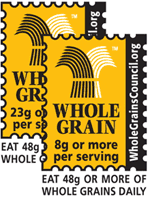By Shaun Chavis
When I heard the words whole grains, the first image that popped into my head was a not-so-pleasant childhood memory of my mom trying to stealthily swap regular spaghetti for whole-wheat. My two sisters and I were not fooled! We shoved our plates away and complained enough that poor mom never thought about serving whole-wheat pasta again.
My connotation of whole grains quickly changed when I attended a conference called "Make (at Least!) Half Your Grains Whole!," hosted by the Whole Grains Council and the Oldways Food Issues Think Tank. These are the same folks who created the Mediterranean Diet pyramid and who are responsible for the yellow Whole Grains stamp you see on foods at the grocery.
Whole-grain foods—and science—have come a long way since my mom tried that little switcheroo. First, the science: Whole grains are associated with a lower body mass index (BMI) and improved satiety. One Dutch study showed that women's risk of obesity was four percent lower for every gram of whole grains in their diets. People who eat whole grains also have better blood sugar, lower blood pressure, and lower risks of diabetes and heart failure. The health benefits may come from the extra nutrition—whole grains have fiber, antioxidants, essential fatty acids, and other great-for-you components—or, people who eat whole grains may eat healthier and live healthier lifestyles.
 whole-grain-stamp-150.gif . Don't worry if the grains have been rolled, cracked, broken, ground, pre-cooked, or crushed. As long as you get all three parts of the grain—the bran, germ, and endosperm—you're good to go.
whole-grain-stamp-150.gif . Don't worry if the grains have been rolled, cracked, broken, ground, pre-cooked, or crushed. As long as you get all three parts of the grain—the bran, germ, and endosperm—you're good to go.
Watch out for "degerminated" foods, which have had the germ removed. Also look out for "pearled"—those grains have had the bran removed to make them faster to cook. However, once the bran is removed, they're not whole grains anymore. (Semi-pearled is okay.)
Nutritionists and the 2005 U.S. Dietary Guidelines also encourage making at least half the grain foods we eat whole-grain foods (that's at least three servings a day, or about 48 grams). Right now, only 11% of Americans eat whole grains that often.
Next: Quick ways to get whole grains Try working whole-grain foods into your diet by swapping them for refined-grain foods you'd otherwise eat. You'll avoid adding calories to your diet, and the calories that you eat will be better for you. Here are some ideas to get you started:
Rise and shine and get your grains
- Cereal is one of the most common ways Americans get their whole grains, but be sure to check the ingredient list to make sure it says "whole grain."
- Don't be afraid to try different whole-grain flakes or puffs like rice, corn, kamut, millet, spelt, and amaranth.
- Add some flavor to cooked whole grains—like whole oats and whole corn grits—by serving them with dried fruit or a sprinkle of chopped nuts.
- Muesli (Bob's Red Mill has a tasty mix) with yogurt gives you an added boost of calcium.
Whole-grain noshes
- People who eat popcorn consume about 250 times more whole grains than people who don't eat popcorn. Pop some in the microwave tonight, but skip the butter if you're watching your weight.
- When you're jonesing for a crunchy snack, reach for whole-grain tortilla chips, or whole-grain rice chips. Some of my favorites include RiceWorks crisps, Michael Season's chips (with some at 110 calories a serving), and Snyder's of Hanover whole-grain cheese puffs and pretzels. Just try not to scarf the whole bag, 'kay?
Smart sides
- Choose whole-wheat or whole-corn tortillas. (A whole-corn tortilla adds a nice authentic taste to a soft taco.)
- Whole-grain pastas are better than ever, and don't be afraid to try varieties made with spelt, farro (yum!), amaranth, brown rice, and quinoa.
- If you're worried your kids—or, you!—might have the same reaction that I had as a child, there are some pastas that blend refined flour with whole grain so the difference isn't as noticeable.
- Get hooked on whole grains by starting with your favorite pasta recipe (or find one at Health.com's recipe library). Instead of noodles, pick a whole grain and boil it instead—and substitute the cooked grain for pasta in the recipe. Try farro, bulgur, and quinoa.
- Seeds of Change and Uncle Ben's both have whole-grain brown rice mixes you can zap in 90 seconds.
- Arrowhead Mills has several pancake and waffle mixes with whole grains. You can also find whole grains at drive-thrus and restaurants—just ask, or check out this list of restaurants serving whole grains.
Gotta have gluten-free? A number of grains have no gluten, perfect for people with celiac disease and wheat allergies. For starters, try corn, rice, wild rice, amaranth, and buckwheat.
